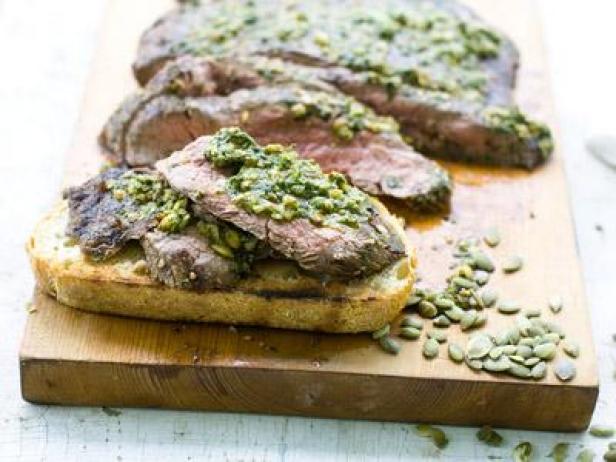Off the Beaten Aisle: Pepitas

Plenty of people have a tough time taking pumpkin seeds seriously.
Fair enough. Americans unfamiliar with (or lacking a taste for) Hispanic foods generally only encounter them in the glop you scrape out of jack-o'-lanterns.
But roasted, hulled pumpkin seeds (properly known as pepitas) are a delicious, nutty backbone of many Mexican dishes and well worth getting to know.
And thanks to the popularity of Hispanic foods, they are easy to find. Trader Joe’s alone sells several varieties -- raw, roasted, salted and plain, among others.
Pepitas resemble long, narrow teardrops and are greenish in color (because their hard, white hulls have been removed). Don’t buy regular “snacking” pumpkin seeds still in their hulls.
Like many nuts and seeds, pepitas taste best when toasted and salted. The flavor is nutty, pleasantly oily and crunchy, but not hard.
If you can only find raw pepitas, they are easy to toast at home. Simply add a handful or so to a dry skillet over medium heat. Stir constantly until the seeds puff and begin to brown. If you like, stir in a few drops of vegetable oil, then salt.
Traditionally, pepitas are used both ground and whole. They often are included in mole, a rich and thick sauce-like dish that usually includes chicken. They also can be mixed into roasted vegetables (especially butternut and other squash varieties) for a pleasantly nutty crunch.
Pepitas really shine when added to salads. Think of them as this decade’s update of the rather tasteless sunflower seeds that have long populated salad bars.
- Make a salty snack that is more addictive than popcorn. Place about 1 cup of raw pepitas in a dry skillet over medium heat. Stir for several minutes, or until the seeds begin to brown and puff up. Remove the pan from the heat and quickly splash in soy sauce, stirring until the seeds are coated and dry.
- For an even more flavorful snack, follow the above toasting process, but skip the soy sauce. Instead, stir in a few drops of vegetable oil and whatever seasonings you enjoy. Cayenne, chili powder, cumin, garlic powder, smoked paprika, salt and black pepper (alone or combined) would be fine choices.
- Add toasted (and salted, if you like) pepitas to a salad of avocado, chopped fennel bulb, diced red onion and lime vinaigrette.
- Sprinkle salted pepitas over squash or pumpkin soup. They also pair well with a creamy corn chowder (especially if you add a bit of heat to the chowder, perhaps by way of diced jalapeno).
- Add pepitas to the granola you sprinkle on your yogurt. Or ditch the granola altogether and just go with the pepitas.
- Add them to chocolate chip cookies. If you really want to blow people away, toss in some dried tart cherries, too.
- Use pepitas in place of pine nuts when making pesto. And while you’re at it, substitute cilantro for the basil, and add a splash of lime juice.
This bold sauce is inspired by chimichurri. The steak can be served alone with the sauce, or thinly sliced over toasted bread.
In a large bowl, whisk together the olive oil, vinegar, garlic, salt and pepper. Add the steaks, turn to coat, then refrigerate for 30 minutes (or up to several hours).
To make the sauce, in a food processor combine the parsley, cilantro, pepitas, olive oil, vinegar, oregano, cumin, salt, garlic and red pepper flakes. Process for 2 to 3 minutes, or until very smooth.
Heat a grill to high.
Remove the steaks from the marinade, then grill for 7 minutes per side for medium-rare. Transfer the steaks to a cutting board and let rest for 5 minutes.
Slice the steaks across the grain into thin slices. Serve topped with the sauce.
Nutrition information per serving (values are rounded to the nearest whole number): 750 calories; 500 calories from fat (67 percent of total calories); 55 g fat (11 g saturated; 0 g trans fats); 75 mg cholesterol; 6 g carbohydrate; 55 g protein; 2 g fiber; 740 mg sodium.
Read more Off the Beaten articles including pancetta, mint and marcona almonds.
J.M. Hirsch is the national food editor for The Associated Press. He is author of the recent cookbook, High Flavor, Low Labor: Reinventing Weeknight Cooking . He also blogs at jmhirsch.
































